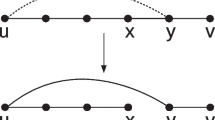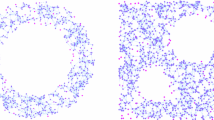Abstract
We lay down the foundations of a new approach for finding the network connectivity in wireless networks, with special regard to the properties of dependencies between links of geometrically collocated nodes. The proposed methodology is rooted in the theory of random graphs, but we significantly extend the conventional random graph model, as in its original definition it would be too sterile to capture realistic wireless networks. A closed form expression for the network connectivity was derived by an equilateral hexagon topology introduced from the minimum set covering problem. We also analyzed the effect of boundary nodes on the connectivity of an infinitely and a finitely large network. Through a combination of mathematical proof and simulations, we have shown that our result provides a robust performance in wireless networks.
Similar content being viewed by others
References
Kortuem G (2002) Proem: a middleware platform for mobile peer-to-peer computing. Mob Comput Commun Rev 6(4):62–64
Chlamtac I. Faragó A (1999) A new approach to the design and analysis of peer-to-peer mobile networks. Wirel Netw 5(3):149–156
Faragó A (2002) Scalable analysis and design of ad hoc networks via random graph theory. In: Proc. of the DIALM. ACM, New York, pp 43–57
Hekmat R, Van Mieghem P (2006) Study of connectivity in wireless ad-hoc networks with an improved radio model. Mob. Netw. Appl. 11(3):351–360
Hekmat R, Van Mieghem P (2003) Degree distribution and hop-count in wireless ad-hoc networks. In: Proc. of the ICON pp 603–609
Erdös P, Rényi A (1960) On the evolution of random graphs. In: Proc of Hungarian academy of sciences, pp 17–61
Seet B-C (2009) Mobile peer-to-peer computing for next generation distributed environments. IGI Publishing, Atlanta
Kershner R (1939) The number of circles covering a set. Am J Math 61(3):665–671
Newman MEJ (2005) Random graphs as models of networks. In: Handbook of graphs and networks. Wiley-Interscience, New York, pp 35–68
Santi P, Blough DM (2002) An evaluation of connectivity in mobile wireless ad hoc networks. In: Proc of ICDSN. IEEE Computer Society, Los Alamitos, pp 89–102
Virtanen S. (2003) Properties of non-uniform random graph models. Dissertation, Helsinki University of Technology
Wang P, Gonzalez MC (2009) Understanding spatial connectivity of individuals with non-uniform population density. Philos Trans R Soc, Math Phys Eng Sci 367:3321–3329
Ou Z-H, Song M-N, Zhan X-S, Song J-D (2008) Key techniques for mobile peer-to-peer networks. J Syst Softw 19(2):404–418
Niu X-Z (2008) Several key techniques for mobile peer-to-peer networks. Dissertation, University of Electronic Science and Technology of China
Author information
Authors and Affiliations
Corresponding author
Rights and permissions
About this article
Cite this article
Zuo, K., Wang, H., Wu, Q. et al. Connectivity model of wireless networks via dependency links random graphs. J Supercomput 58, 122–141 (2011). https://doi.org/10.1007/s11227-010-0529-5
Published:
Issue Date:
DOI: https://doi.org/10.1007/s11227-010-0529-5




